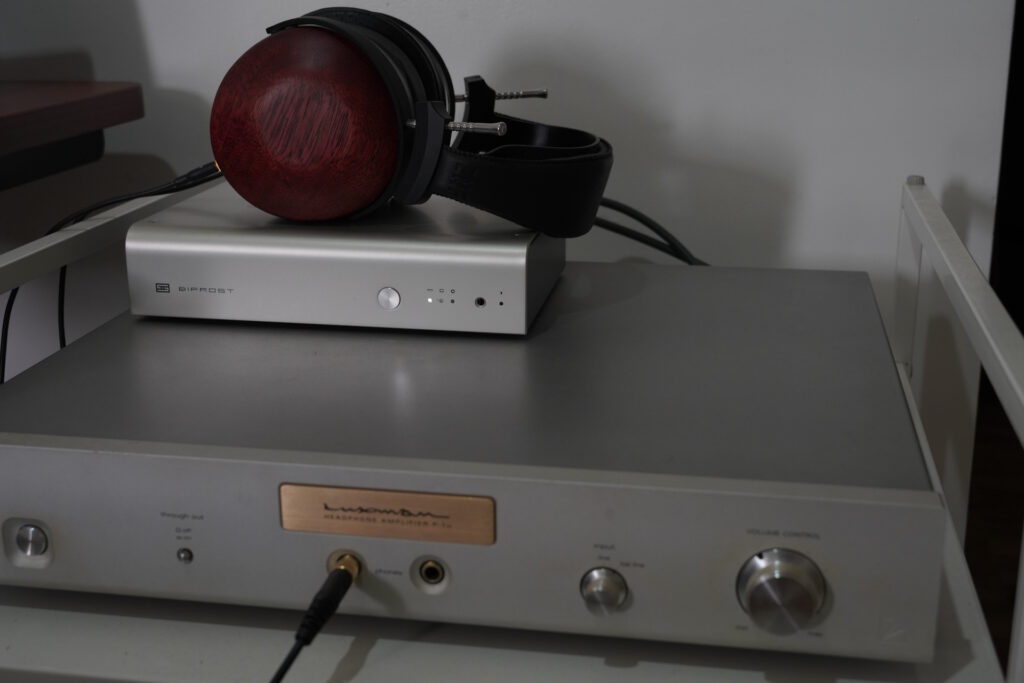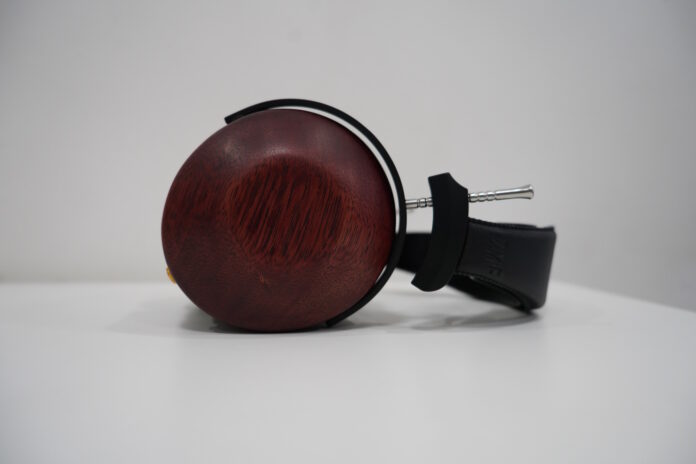Sound
This is my first ZMF headphone purchase, but I’ve auditioned many of their models before, so I had a good idea of what to expect. My setup includes a Luxman P1u amplifier and a Schiit Bifrost 2 DAC connected to a Windows laptop. However, I’ve spent a significant amount of time using the Bokeh unamplified, directly from the headphone out of a laptop, which I’ll explain shortly. Whether connected to my laptop’s audio port or an older smartphone like the LG G8 with its built-in DAC, I found the Bokeh delivered impressive performance.
Before diving deeper into the sound, let’s quickly touch upon the tonal profile of the Bokeh with the hybrid pads, the additional set not installed by default. These pads offer a more neutral presentation with less bass and a more forward upper midrange. This doesn’t mean the headphone becomes bass-light or treble-tilted; it just shifts the balance slightly. Personally, I prefer the sound of the protein pads, but preferences vary, and both options are included in the package.
Most of my evaluation was done using the protein pads, so unless I specifically mention frequency response differences, my impressions are based on these pads.
The overall sound signature of the Bokeh is warm and slightly bassy, with laid-back upper frequencies. If you prefer a neutral profile, the Bokeh might not be for you unless you’re into EQ or pad rolling. But if you enjoy a fun, musical sound, you’ll likely love the Bokeh.
Starting with the bass, the extension is excellent, though there is some emphasis around the mid/upper bass region, which can cause a bit of bleed into the midrange, adding warmth. For most of the music I listen to, this adds a pleasant character. There’s a bit of that closed-back reverb that you often get with wooden headphones, and I find it enjoyable.
The rest of the frequency response is subdued compared to the Harman Target, resulting in a smooth overall sound. I don’t feel the need to lift the upper mids, and while the treble might be too recessed for some tracks, it’s not a dealbreaker for me. If I want a more “audiophile” experience, I can turn to my Focal Utopia, HiFiMAN HE1000, or Sennheiser HD800s. But for casual listening or enjoying Taylor Swift’s latest album while working, the Bokeh is more than sufficient.
As for the hybrid pads, I initially thought they would enhance my experience by taming the low frequencies and bringing up the highs. However, I found that they reduced the enjoyment factor, which is subjective, by flattening the sound too much. The Bokeh’s warm, euphonic character is its strength, and I felt the hybrid pads diminished that. Your experience may differ, and some may prefer the hybrids over the protein pads.
The Bokeh’s performance is quite pleasing. Dynamics are impressive for a closed-back headphone with a warm sound, the soundstage is larger than expected, and the resolution is satisfying. It’s not going to match my open-back headphones in resolution, but it’s not intended to.

The biggest surprise for me was how good the Bokeh sounds without amplification. There’s a big convenience factor here. Perhaps my Luxman P1u and Bifrost 2 setup is too similar in character to the Bokeh, but I found I preferred the sound directly from my LG G8 phone or Asus laptop. I’d be curious to try the Bokeh with a high-end solid-state amplifier, but I’m content with the sound from these simpler sources.
That’s not to say the Bokeh sounds poor from my DAC/amp setup, but it does become a bit too warm and relaxed for my liking. My setup is optimized for the Focal Utopia and Sennheiser HD8xx, which may explain why the synergy with the Bokeh isn’t ideal.
Comparison
I don’t have many closed-back headphones, so my comparison section will be brief. The Bokeh isn’t the best closed-back headphones I’ve heard—models like the ZMF Verite Closed and Focal Stellia offer more incisive sound and better treble response—but they also come at a significantly higher price point.
In my own collection, the Bokeh is difficult to compare with older models like the Audio-Technica ESW9 or the discontinued Audeze Sine. The closest comparison would be to the HiFiMAN Edition X, which, like the Bokeh, sounds good even without external amplification. But the Edition X is an open headphone so they’re not even the same type.
Conclusion
For me, the Bokeh’s biggest strength is its portability and how well it performs with basic sources. Sound is subjective, and what constitutes “good sound” varies from person to person. If you’re drawn to a warm, relaxed sound and have other headphones to meet your audiophile needs, the Bokeh is a great buy.
If your priority is finding the best, most resolving headphones under $1,000, the Bokeh will be easily outclassed by many open-back models, even those that cost significantly less. But the Bokeh should be on your radar if you’re after a portable, sealed headphone that doesn’t require amplification to shine. Plus, it really looks fantastic and the materials are premium.
The Bokeh also offers flexibility in tuning through pad rolling, adding mesh inserts, or using EQ. There’s plenty to explore if you’re willing to do any of those. If not and you don’t like this kind of tuning, then the Bokeh may not be for you.
Go check out ZMF Bokeh on ZMF’s website for the full details on the product. Catch you on the next headphone review!


